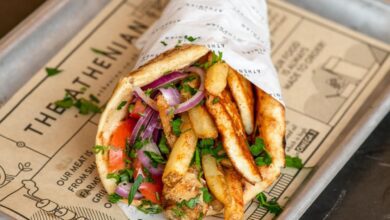Pulling back the curtain on Eataly London
Director of store operations for Eataly, Enrico Prodi, tells us about his career with the the largest Italian food market and restaurant concept in London and what has made its expansion plans tick up until this point

Register to get 1 more free article
Reveal the article below by registering for our email newsletter.
Want unlimited access? View Plans
Already have an account? Sign in
Can you tell us a little bit about your career and how you ended up working for Eataly?
After spending a few years in accounting, consultancy and insurance, I was looking for a new challenge in the hospitality sector. My journey with Eataly began in 2016 when I joined the team as a business controller in Rome and the North-western region of Italy, where I managed financial planning and analysis. In 2018, I ventured to Los Angeles as the financial planning and analysis manager at Eataly, looking after the LA and Las Vegas regions. Then I moved from the West Coast of America to Boston in 2021 as Eataly’s director of store operations, and after a year, I joined Eataly London. Since January 2023, I have been acting as director, heading up all of Eataly’s European branches alongside.
What are your responsibilities as director of store operations?
As a director of store operations at Eataly, I oversee both qualitative and quantitative aspects of all European stores, including Italy, Stockholm, Munich and London. From the store’s appearance and atmosphere to service policies, staff training, looking after the marketing, events and promotions calendar, as well as all key relations with local businesses and partners on that specific market. I also head all teams of store managers in Europe, and I’m in charge of all store P&Ls.
How has the business managed its expansion so far, and what are your tips for other businesses that wish to expand?
The Eataly London store opened at the end of April 2021, overlooking the city of London in the middle of the pandemic, with the presence of the London Mayor, Sadiq Khan. It was a staggered opening, first opening the retail-side, followed by the restaurant. After almost two years of business, there are still many clients from London and outside of the city that need to discover our Eataly experience. Therefore, every day is a new opportunity to attract a different kind of customer.
We are positive and excited about the future; our year will be filled by looking at new projects and collaborations, bespoke events, and festivals and restaurant reopenings, just to name a few. Overall, my main tip for other businesses is to carefully monitor the quality and standard of the services you provide each day.
In your opinion, what are the most popular Italian dishes among Brits?
The biodiversity and gastronomic traditions of Italy are so vast that there is always more to explore and discover. We change our offer seasonally and offer a range of dining and shopping experiences so that there is something for everyone to enjoy. Pasta and pizza dishes still remain by far, the most popular dishes on our restaurant menus. Iconic dishes at Eataly London include our carbonara, pizza margherita and our signature dish spaghetto Eataly, made with 4 simple ingredients straight from our market: Italian wheat spaghetti, whole red datterino tomatoes, extra virgin olive oil and fresh Genovese basil DOP (Denominazione di Origine Protetta – “Protected Designation of Origin”).
Finally, let’s not forget our Cornetti pastry, the hero offering in our Quick Service Restaurant. These pastries have gone viral on Instagram, because of their traditional recipe, abundant filling and the unique in-house techniques from our patisserie specialists. Our pastry chefs make each pastry from scratch every morning at 5am in our in-house laboratories to ensure the freshest pastries for our customers.
From a drinks standpoint, I have never seen such a heavy revenue stream from Aperol Spritz in any other Eataly in Europe.
What Italian food trends should restaurateurs be anticipating amongst consumers?
I believe there will be a greater consumer attention to the simplicity of dishes, while consumers are also becoming more curious and interested in the origin of the ingredients used in their dishes. For example, it will no longer be enough to say, ‘spaghetti made with tomato sauce’ – restaurateurs need to specify where the ingredients originate from, if the recipe is true to its tradition, and how it is cooked. To sum up, transparency throughout the whole supply chain is essential, from food production to reaching customers’ plates.







